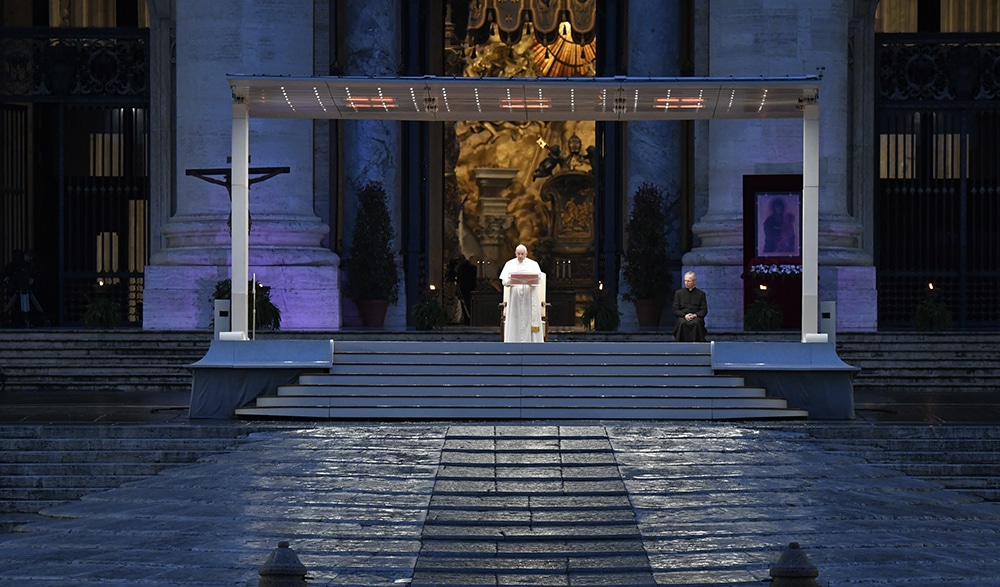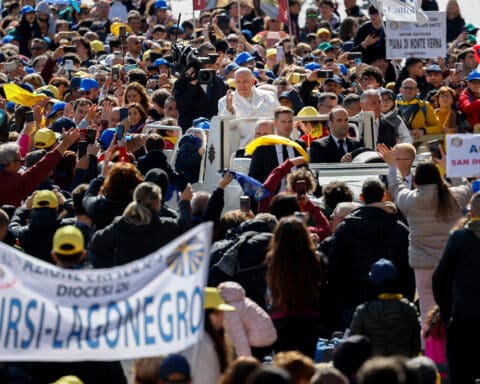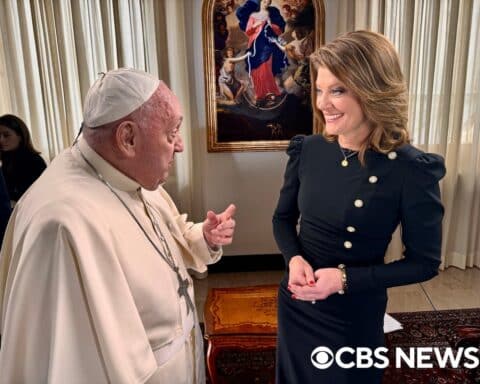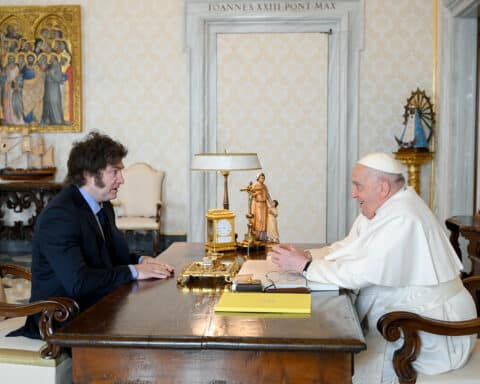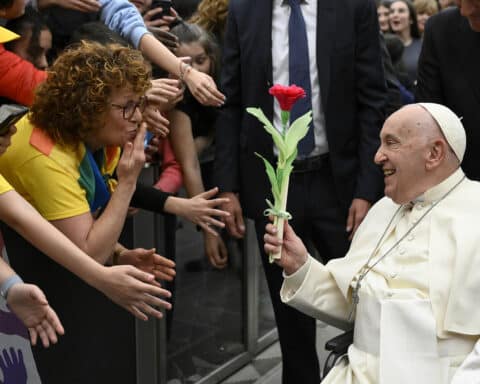Moment by moment, sign by sign and word by word, Pope Francis has defined his papacy in the 10 years since his election to the See of Peter. Through iconic gestures and memorable quotes, the Holy Father has used his service in the Petrine ministry to call Catholics throughout the world to be animated, living bearers of the Gospel. As the Church marks the 10th anniversary of Pope Francis’ election as bishop of Rome, now is an appropriate time to ask: What is the charism of Pope Francis? What is his special contribution to the Church?
On this occasion, we have the opportunity to revisit the quintessential Pope Francis moments. If viewed as moments of the past and points of an agenda to be untangled or interpreted, they remain constrained by the unreflective habits of thought we use to evaluate our celebrity and political figures. But if we view them as insights into Christian living, they become more powerful — timeless invitations to better conform our lives to the Gospel.
Initially, some thought Pope Francis might have chosen his name in honor of the saintly Navarrese missionary, Francis Xavier, who was a cofounder of the Society of Jesus. The Vatican clarified early on that the pope’s namesake was, in fact, Francis of Assisi. During the election in the Sistine Chapel, Cardinal Claudio Hummes, archbishop emeritus of São Paulo, Brazil, and prefect emeritus of the Vatican’s Congregation for the Clergy, congratulated the newly elected pope, Jorge Bergolio, and urged him, “Don’t forget the poor!” Those words struck Cardinal Bergoglio, who immediately thought of Francis, known to be a patron of peacemaking and for the care of creation.
The day after his election, Pope Francis, in his first act as pope, visited Santa Maria Maggiore, where he paused to pray at the tomb of Pope St. Pius V. Commentators took special delight in the image of the Jesuit pope named Francis praying before a Dominican saint. But the visit had deeper symbolism still. Pope Pius V was a renowned reformer of the Roman Curia. He was famous for walking the cold, marble floors of the apostolic palace barefoot and for his special affection and care for the poor of Rome. St. Pius V even forewent the customary festival thrown for a newly elected pope and gave the money instead to the poor, personally washing their feet and caring for the sick.
The pope’s daily homilies during the Masses he offered and preached from Casa Santa Marta provided insight into the spiritual life widely appreciated throughout the Church. His regular references to Satan, denouncing the prince of lies, and offering clear, practical advice on how to better hear the voice of Jesus were appreciated by many. For years, around 50 people a day joined him for those Masses, with 25 of those 50 seats reserved for Romans, so that local pastors could bring groups of parishioners to pray with the pope.
On Easter Sunday 2013, a photo of Pope Francis took the world by storm. While touring St. Peter’s Square after Mass, the pope embraced 8-year-old Dominic Gondreau. The young boy with cerebral palsy was lifted up by the crowd to the pope in the popemobile, and he gently embraced him and blessed him. Dominic, who suffers from extremely limited physical mobility, raised his arm and put it around the pope. The image became iconic, reprinted on newspapers and carried on websites across the globe, showcasing the pope’s special love for the sick and disabled.
Pope Francis’ special love for the poor was given greater attention with his concrete actions.
He has regularly dined with those experiencing poverty, including on the World Day of the Poor, which he established during the Jubilee Year of Mercy in 2016. Pope Francis has supported mobile health clinics in St. Peter’s Square and renovated a public restroom to make showers available to the homeless.
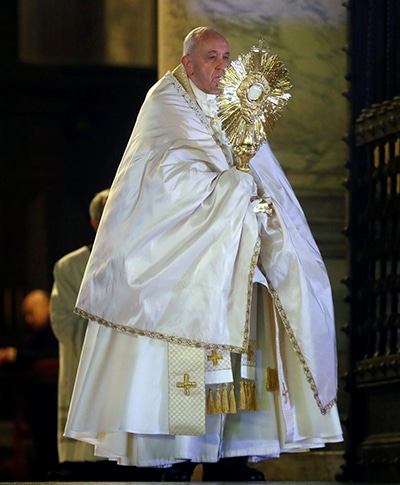
In his writings, Pope Francis has drawn the attention of the global Church to themes dear to his patron. In his first encyclical, Lumen Fidei, he concluded Pope Benedict XVI’s trilogy of encyclicals on the theological virtues, calling for special attention to be given to recovering the light of faith in our day. In Laudato Si’, which begins with a canticle of praise authored by Francis of Assisi, Pope Francis urges the Church to make increasingly greater efforts for the care of creation. In Fratelli Tutti, he called for members of the Church to work for the common good of the social order, fostering interreligious dialogue and peace.
At the height of the COVID-19 pandemic lockdowns, Pope Francis arranged for a special urbi et orbi address to be made from St. Peter’s Square. In an unforgettable scene, with blue police lights eerily flashing and fires flickering, Pope Francis called the Church to place our confidence in Christ, who would care for his beloved boat, the Church, just as he once tended to the apostles tossed about the stormy seas. The Eucharistic Benediction, with Pope Francis standing alone, holding a monstrance, braced against all the suffering of the world, was a sight that will not be erased swiftly from the annals of Church history.
In his apostolic journeys, the pope has diligently worked to foster relationships with the Islamic world. Pope Francis was the first pope to visit Iraq, traveling to the war-torn nation to offer healing. Several years before, Pope Francis made history by becoming the first ever pontiff to visit the Arabian Peninsula, traveling to the United Arab Emirates in 2019. The Abrahamic Family House, a new interfaith center which includes a church, a synagogue and a mosque, came about as a fruit of that pilgrimage.
And what will the future icons be? Some continue to see great symbolism in his visit to the tomb of St. Celestine V last summer. Celstine V was the last pope to voluntarily resign before Benedict XVI did so in 2013. As rumors about the pope’s health rise and fall, he offers little indication that a resignation is anywhere on the horizon. Perhaps the best indication, like so much of his papacy, is to be found in the example of his namesake, Francis, who followed Christ in zealous service to the last of days.
Our Sunday Visitor Editorial Board: Father Patrick Briscoe, Gretchen R. Crowe, Scott P. Richert, Scott Warden, York Young

